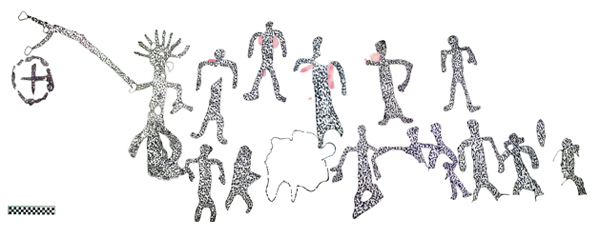The Narrows Rock Art Panel
By Deborah Sabo One of the most important rock art expressions in northwest Arkansas is the panel at The Narrows rock shelter site on Forest Service land in Crawford County. The Narrows was first reported by archeologists in the 1930s and unfortunately has been the scene of much unauthorized digging over the years. The main panel of rock art at the site has as many as sixteen human figures (one is barely suggested). They are painted petroglyphs, pecked into the back wall of the shallow sandstone rock shelter, and then filled in with black paint.
This panel shares some characteristics with Plains rock art in the way it depicts the human form, with long, more-or-less rectangular bodies. Legs sprout from the lower corners of the rectangle, arms from the upper corners, or "shoulders." The arms and legs are stick-figure style. Arms are bent downward in a square-at-the-elbow posture. Feet, if shown, are turned outward. Heads are small ovals fixed to the bodies with slight indication of a neck. The figure at the left is marked off by a series of distinguishing features: larger size and "honorific" or leadership position in relation to the other figures; headdress; possible kilt or birthing effluent; holding a long forked pole in one hand and curved object (or supernatural appendage) in the other. The pole is apparently in relationship to a cross-in-circle motif just below it. This symbol represented the sun and the world center in many Southeastern and Plains Indian religious iconographies.
The other figures are arranged in two rows. The "flat" perspective common in much non-Western art, including many American Indian styles, might have meant this as a conventional way to show people forming a circle. This lends itself to one possible interpretation of The Narrows panel: that it represents a community group performing a circle dance that reenacts a creation myth or other important cultural narrative. For example, an Osage creation story tells how the "Little Ones" descended from the stars, floating down to land in the tops of tall trees, with their arms held out like wings. The Osage at one time performed a dance imitating this story, and perhaps the petroglyphs illustrate some similar performance.
There are many other intriguing features of The Narrows panel, and we are nowhere near a definitive interpretation. For instance, notice that some of the figures have red pigment spots applied in the shoulder and underarm areas. There are any number of possible meanings for this, but at present the only thing we can say for sure is that the red color is restricted to figures in the top row. Another interesting feature is the strangely "boomerang" shaped appendages on several of the figures. Are they all holding some similar object, or does this signify a co-relationship? The forked shape slightly resembles a deer hoofprint. Human figures with deer hoofs for hands have been associated with female imagery at the Maddin Creek petroglyph site in Washington County, Missouri.
Something else of interest about The Narrows panel is the appearance that it represents a family or community group. The different statures represented in the two rows of figures (leaving aside the "leader" figure for the moment) suggests parents and children, especially the grouping at the lower right, which appear to be connected to one another, linked arm-in-arm or holding hands.
Another suggestion, wholly different from the possible interpretations mentioned so far, is that the panel depicts chunkee or stick-ball players. Chunkee was a game played with large disc-shaped stones. Stick-ball was a game similar to lacrosse. These games were not simply for sport or competition, but also had religious and ceremonial importance. A Siouan myth cycle tells how the culture hero Red Horn took part in primeval games, including a footrace in which the race course was the rim of the world and the goal was the place where the sun sets, and a stick-ball game played against giants.
The Narrows panel, packed with symbolism, offers many interpretive possibilities. At this point, all we can say for sure is that it portrays an important cultural narrative. |
| Home | Quick Facts | Interpretations | Articles | Technical Papers | Resources | Database | Just For Kids | Picture Gallery | Buy the Book! |
|
Last Updated: October 1, 2007 at 2:27:13 PM Central Time
|

